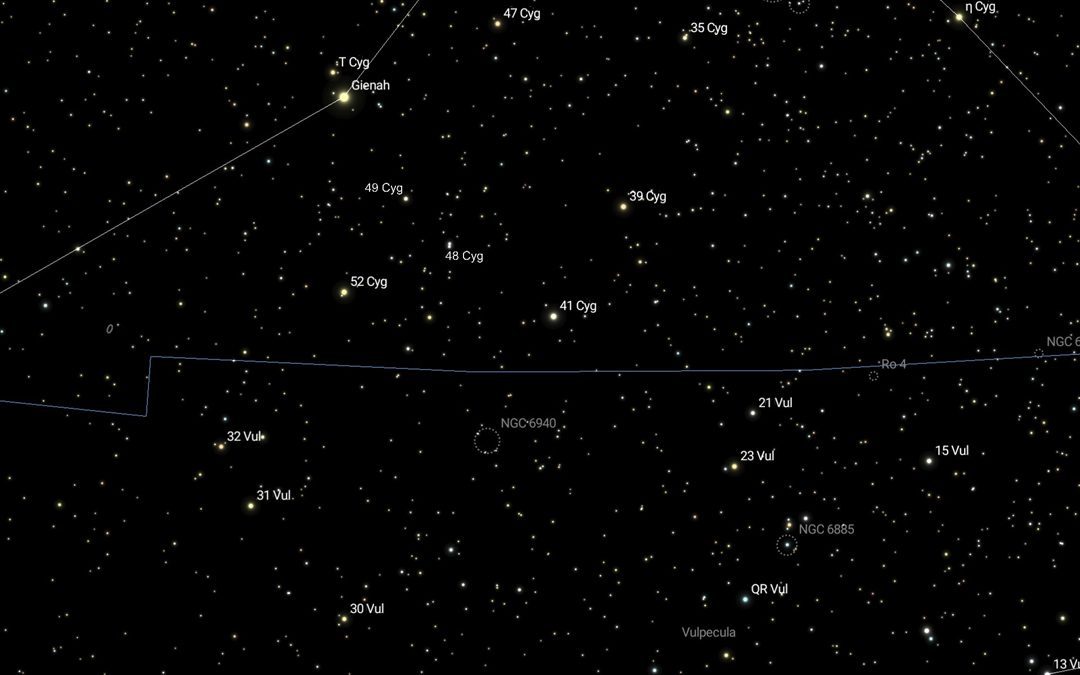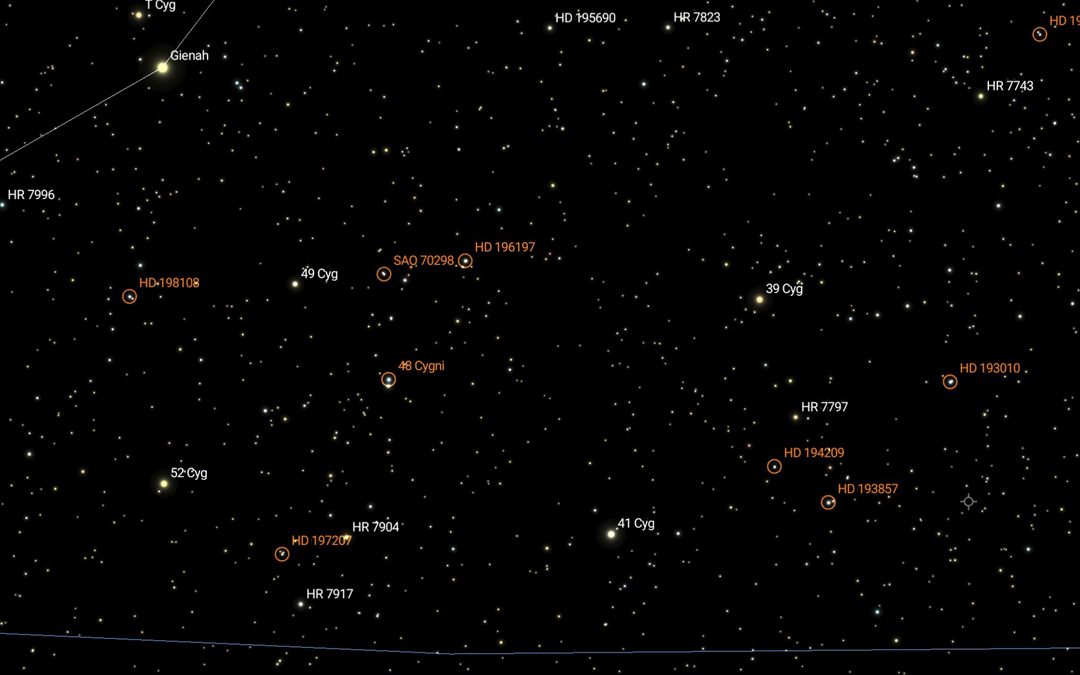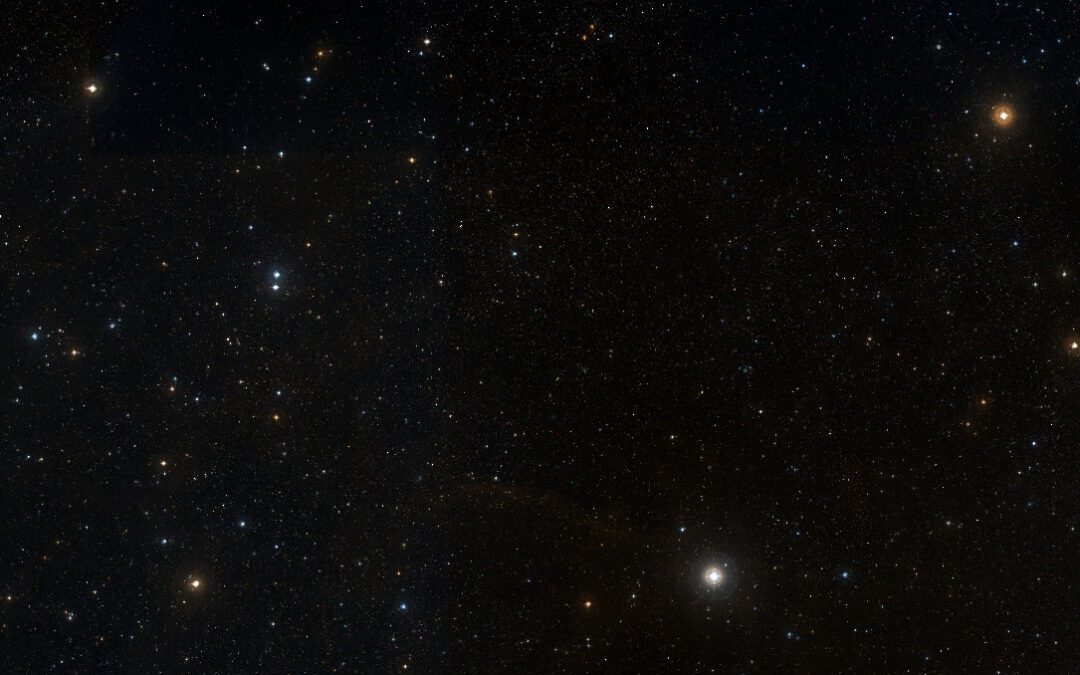I observed the 48 Cygni starfield Thursday evening, September 14, 2023, from the east side of my yard because Cygnus is migrating to the west now and passing behind the dreaded pines of roam near my driveway. (Massive pine trees that block the western side of the sky forcing me to roam the yard for a better view. 😕) My next door neighbor graciously turned off his driveway security light and also minimized the use of lights in the second story bedroom and bathroom overlooking my east yard (which was going way above and beyond courtesy, IMO). I am blessed with wonderful neighbors.
Forty-eight Cygni, aka STFA 53, is a double star included in the Cygni 100 list and appears middle left in the above SIMBAD image. The four bright stars also in the image are 49 Cygni (top left), HR 7904 (bottom left), 39 Cygni (top right), and 41 Cygni (bottom left). The brilliant 52 Cygni (occluded by the famed Veil Nebula, not visible in urban skies) is just out of view to the lower left.

Here is my yard astronomy cart, provisioned with a few binoculars for the session, plus my Sky Safari tablet, notebook, and mechanical pencils. The binoculars are an APM 20×80 ED MS (upper left), a Nikon 18×70 IF WP (upper right), and from lower left to right, a Nikon 7×42 EDG, a Bushnell 10×50 Engage EDX, and a Meade MasterCraft 10×56 ED Pro.
The EDG is a superlative binocular for wide field astronomy views, going deeper than smaller instruments but still easily hand held and providing a generous 8 degree field of view. Not available from US resellers, Nikon EDG binoculars are still in production and can be purchased new from Kyoei-Osaka in Japan.

This Sky Safari chart shows the 48 Cygni starfield, which is southwest of Gienah, near the constellation border with Vulpecula. Gienah’s name is from the Arabic word “janah,” which means wing. It is one of the stars in the northern cross asterism, marking the east end of the cross beam. The bright 4th and 5th magnitude stars 49, 52, 41, and 39 Cygni provide helpful guide posts for navigating this rich starfield. A lovely stream of stars flows from 39 Cygni south to the bright pair of stars, 21 and 23 Vulpeculae.
STTA 53 / 48 Cygni
6.30/6.49 sep 182.7″ pa 177*
Forty-eight Cygni is a splendid duo of 6th magnitude stars, easily viewed and enjoyed with lower magnification hand-held binoculars. It is an object to look for when scanning the constellation in a quick astronomy break during a busy evening or for a cloud hopping adventure. With mounted 20×80 binoculars the pair is captivating, brilliant white and white-gold stars, evenly matched and widely spaced. The colors reflect the B8IIIn and F0V spectral types of the two stars. The color indexes are -0.091 blue-white and +0.345 yellow-white. It is an optical pair – the A star is 818.85 light years distant, while the B star is 163.17 light years away, so the two stars are nearly 656 light years apart.
STT is the discoverer code for the Russian astronomer Otto Wilhelm von Struve (1819-1905); STTA is the code for an appendix of additional double stars published after his initial catalog. STTA 53 references: StelleDoppie page; SIMBAD page.

My Cygni 100 observing list has been highlighted in this Sky Safari chart to indicate seven additional double stars near 48 Cygni which I observed during the session.
ARY 61 / HD 198108
7.40/8.80 sep 98.86″ pa 237.1*
At the apex of a triangle with 49 and 52 Cygni as the base. A bright white primary with a dusky yellow secondary, widely spaced. Primary much brighter. In an asterism that looks like my broad-brimmed Tilly hat.
ARY is the discover code of R.W. “Bob” Argyle, editor of Observing and Measuring Visual Double Stars and co-author with Mike Swan and Andrew James of An Anthology of Visual Double Stars. Bob Argyle worked at the Cambridge University Institute for Astronomy (retired in 2010) and has been the Director of the Web Society Double Star Section since 1970. ARY 61 references: StelleDoppie page; SIMBAD page.
ARY 28 / HD 197207
AB 8.24/9.44 sep 60.65″ pa 331.7*
AC 8.24/9.66 sep 104.06″ pa 35^
All three stars white. The primary is brighter. The C component, while easily seen with 20×80 binoculars from my urban yard is fainter than the 9.5 magnitude limit for the Cygni 100 list, so only the AB pair is included in the catalog. ARY 28 references: StelleDoppie page; SIMBAD page.
ARY 48 / SAO 70298
8.17/8.69 sep 53.11″ pa 40.5*
White primary with a deep yellow (grapefruit orange) companion at a comfortable distance. Primary slightly brighter. In a gorgeous field, including 48 Cygni, 49 Cygni, and STF 2700. A celestial treat. ARY 28 references: StelleDoppie page; SIMBAD page.
STF 2700 / HD 196197
6.864/9.10 sep 24.03″ pa 283.8*
Brilliant white primary with a tiny white companion nestled at its side. Cozy but not tight. A pleasing 20x double. Same gorgeous field as noted for ARY 48. From the spectral types and color indexes of the two stars, the primary might be seen as yellow compared to the secondary – K1+IIIa +1.144 versus F2IV-V +0.34. Something to note and consider on a subsequent visit.
STF is the discoverer code of Friedrich Georg Wilhelm von Struve (1793-1864), born in Altona, Denmark (which is now in Germany), his family subsequently emigrated to Russia. A seminal figure in double star research, Struve is credited with discovering 2,343 double stars. He founded an astronomy dynasty extending to four generations, including his son Otto Wilhelm von Struve mentioned above. STF 2700 references: StelleDoppie page; SIMBAD page.
ARY 4 / HD 193857
6.749/8.50 sep 134.84″ pa 286.5*
Brilliant blue-white primary with dull yellow secondary, widely spaced. Primary much brighter. Forms a large triangle with 39 and 41 Cygni. ARY 4 references: StelleDoppie page; SIMBAD page.
ARG 91 / HD 194209
8.57/9.47 sep 20.55″ pa 175.4*
A cozy double. The secondary is somewhat shy and takes a moment to reveal itself at 20x. Primary much brighter. One corner of a quadrilateral inside the triangle formed by ARY 4 with 39 and 41 Cygni. A fine 20x double in a striking and beautiful starfield.
ARG is the discover code of Friedrich Wilhelm Argelander (1799-1875), who was born in Prussia and oversaw observatories in Finland and Germany. He was a pioneer variable star observer. ARG 91 references: StelleDoppie page; SIMBAD page.
HO 588 / HD 193010
6.916/8.87 sep 51.12″ pa 297.3*
Brilliant blue-white primary with a steel-colored companion at a comfortable distance. Primary much brighter. Another fine and pleasing 20x double.
HO is the discover code of George Washington Hough (1836-1909), an American astronomer who discovered 627 double stars. HO 588 references: StelleDoppie page; SIMBAD page.
About Star Colors
Star colors are more apparent in urban skies than at darker sites. In the past I ascribed the urban sky star color “advantage” to the reduced contrast between stars and the light-polluted background sky. However, thanks to a post from Glenn LeDrew (optics maven and frequent Cloudy Nights contributor), the actual cause is that in an urban environment (with many bright white lights about), one’s eyes never fully dark adapt. Dark adaptation reduces color sensitivity at the same time it increases sensitivity to light. Thank you, Glenn. 😉
Star color perception/descriptions also tend to be somewhat subjective and vary from observer to observer, and even for the same observer depending on the sky conditions, equipment used for observation, and the observer’s physical state. My color perceptions are generally consistent with star magnitude and spectral type, and perhaps have improved some with practice, though anomalies occur (as with STF 2700 above where I recorded the primary as brilliant white instead of yellow, which would be more consistent with its K spectral type).
Star color descriptions can have a certain charm, which might be pooh-poohed by non-devotes of the double-star genre but are all part of the fun from my perspective. Here is an example from Sissy Haas’s delightful book double stars for small telescopes, published in 2006 and now sadly out of print. The Cygni 100 double, 26 Cygni (H 5 47AB, 5.2/8.9 sep 41.4″) is described by Haas as “A very wide pair with pretty colors. It’s a brilliant citrus-orange star and a whitish lilac, and the companion is strongly contrasting but easy to see. Webb: ‘Gold or yellow, blue’.” My own color notes from Wednesday 26 July 2023: “Brilliant yellow primary with a tiny grayish-tan companion.” Haas observed the double with a 125mm telescope at 50x, whereas I observed it with a Nikon 18×70 binocular.


I don’t buy the urban sky is better for star color theory. I don’t think that there’s good evidence that your color acuity drops because the background is brighter.
It’s true your rods are more sensitive and seem to be more effective when it’s dark but ultimately the color cones give out the same signal.
I find no difference in star color with regards to sky brightness.
Well, my original thinking was that color acuity increases in brighter skies (not drops) due to the lower contrast. But to Glenn LeDrew’s point, I have concluded the real difference is not sky brightness so much as not being fully dark adapted because of all the local light pollution. That is what Glenn suggested in his Cloudy Nights post. And a way to test it is to get fully dark-adapted, note the color of various stars, then look at a white light to to un-dark adapt (is there a word for that? 😂) and then observe the same stars again noting the apparent colors.
At any rate, I have no doubt star colors are more apparent to me when observing from an urban environment because I have seen the difference for years. I just misattributed the cause until Glenn pointed out what was really happening.